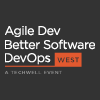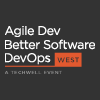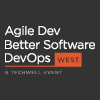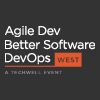Test Design
Conference Presentations
 |
Strategies for Selecting the Right Open Source Framework for Cross-Browser Testing
Slideshow
[video:https://www.youtube.com/watch?v=-M9uWjd4WJY&feature=youtu.be width:300 height:200 align:right] |
Eran Kinsbruner
|
 |
Five Core Values to Focus Your Regression Testing Efforts
Slideshow
In an agile world where having dedicated testers can be a controversial idea, manual testing is a tough sell. Not all contexts have their testing automated, so what is a manual tester to do when it comes time to release? Your team starts asking about regression testing, requests estimates, and expects justifications for the time being spent. Intuition isn't the answer, and retesting everything is not an option. In this session, seasoned tester Brendan Connolly will share his five core values for focusing your regression testing efforts: consistency over correctness, behaviors over bugs, intent over implementation, conformity over complexity, and common over complete. These values not only help with decision-making, but also serve as a heuristic foundation for understanding and communicating about regression testing, as well as define a clear intent and context for all your future regression tests. |
Brendan Connolly
|
 |
Taking Your Automation Framework to the Next Level Using Machine Learning
Slideshow
Automation fails frequently in companies due to a variety of reasons, including poor team communication, lack of skills, flaky tests, and inadequate understanding of test coverage. Even when things are going well, the automated tests sometimes grow to a size where the test suites take too long to execute for the run to be viable. James Farrier is a test automation architect who will show you ways to leverage machine learning to address these challenges. You'll learn how to determine which tests are valuable to run after each commit or build in order to cut down the suite run time, how to automatically close and open defects based on test run results, and how to separate a test into different test runs to keep track of tests in different states. Finally, he will show you how to create a results dashboard that allows for team collaboration and a better understanding of test coverage so that testing can be further streamlined. |
James Farrier
|
 |
Faster Food and a Better Place to Sleep: Applying Agile Outside Software
Slideshow
Agile methods aren’t just for software anymore—actually, they haven’t been for quite a while. Agile's collaborative, iterative, incremental approaches to work have caused it to go mainstream. But can we apply team-based agile straight out of the box in a nonsoftware context? Although most of the principles and patterns apply, sometimes the practices and frameworks need modification for a particular context. Mike Cottmeyer will explore two case studies of agile journeys: an international hotel chain going through a major rebranding initiative, and a well-known fast food restaurant looking to optimize its kitchen production capacity. These are two totally different companies in two totally different industries, both trying to use agile to solve their problems. We’ll look at the challenges each faced, what they had in common, and the patterns, tools, and techniques they are using. |
Mike Cottmeyer
|
 |
Automated Testing for New-Gen Digital Interactions: Chatbots, Alexa, and Siri
Slideshow
Today’s IT systems communicate with customers through multiple points of engagement and various interfaces, ranging from web, mobile, and voice to BOTs and apps like Alexa and Siri. Sanil Pillai says these systems need to provide seamless handoffs between different points of interaction—while at the same time providing relevant and contextual information quickly. To accomplish this, a team must be able to successfully pair device hardware capabilities and intelligent software technologies such as location intelligence, biometric sensing, and Bluetooth. Testing these systems and interfaces is becoming an increasingly more complex task, and traditional testing and automation processes simply don’t apply to new-generation digital interaction services. Join Sanil as he discusses the testing and automation challenges in new-generation digital interactions using hyperconnected BOTs. |
Sanil Pillai
|
 |
AR and VR for Mobile Apps: Are You Ready to Test?
Slideshow
Augmented reality (AR) and virtual reality (VR) mobile apps are going to dominate the technical landscape for the next few years. Compared to current mobile apps, testing this new AR and VR technology will require more preparation, more effort, and new tools. BJ Aberle breaks down the methods and tools he uses to test AR and VR applications. Explore test environment requirements and discover the types of test data you’ll need to prepare for AR and VR testing. Learn about Google’s Tango AR platform and BJ’s experiences testing AR apps, including the Tango-based Cydalion app for the visually impaired. BJ shares the pitfalls he discovered—so you can avoid these when starting your AR or VR testing endeavors. Take back a set of new techniques you may be able to apply to streamline your virtual and augmented reality testing efforts. |
BJ Aberle
|
 |
Five Things We’ve Learned from 100,000 Bug Fixes
Slideshow
[video:https://youtu.be/GRXNPt2IAyY width:300 height:200 align:right] |
Kristel Kruustük
|
 |
Integration and Functional Testing Using Dockerized Dependencies
Slideshow
To emulate production-like conditions that cannot be tested on the unit level, many integration and functional tests need a realistic environment. However, performing these tests in a production-like environment is fraught with problems—test data management issues, tests that are difficult to execute repeatedly, and network traffic that causes long-running test execution times. Instead of having to deal with these problems and others, Irene Dhong employs Docker to simulate dependencies. Learn how you can take advantage of Dockerized dependencies for quick test writing, reusability of common development code, and the ability to test early and often on a very low functional level. Irene describes how her development team is using Docker to implement more effective TDD and unit testing environments because Docker utilizes similar infrastructure both on the development and DevOps side. Join in to get Dockerized, too. |
Irene Dhong
|
 |
Devices and Desires: How Do Humans Experience Software?
Slideshow
We consume and still we desire more—more devices, more apps, more data, more bandwidth, more connectivity. The more we have, the more we want. We assume that to be true—those of us who work in the software industry. But is that true? To understand what is really required of our products, we need to design and test a pyramid of interlocking quality attributes that, together, make for an optimum experience. Isabel Evans discusses why and how we can evaluate UX and what is takes to deliver better UX to our customers. Isabel looks at the needs of the individual software user in conjunction with pressures from the commercial imperatives from the business and external forces from government, the environment, and the needs of society. To test the UX and thus deliver a good experience, we first need to understand the humans who use our products and match their needs and desires to the software’s user experience. |
Isabel Evans
|
 |
Exploratory Testing: Learn to Do It like a Bloodhound
Slideshow
Let’s face it—dogs are born to sniff everything. Using their noses, they gather information from other dogs, people, and most everything. We teach dogs to use their noses to find bombs, predict seizures, locate cancer cells, detect drugs, and so much more. When dogs smell, they are not just recording an odor; they get an entire story. Although testers have fewer scent receptors than dogs, Susan Zampino says that we can learn how to gather information like a dog to drive our exploratory testing. Using active audience participation, Susan will stimulate participants to rely on their sense of “smell” during exploratory testing sessions. Learn and practice multiple new techniques to gather information and uncover hidden risks. With some practice and consistent focus on using your technical, business, and testing experiences, you can become a bloodhound exploratory tester. |
Susan Zampino
|


